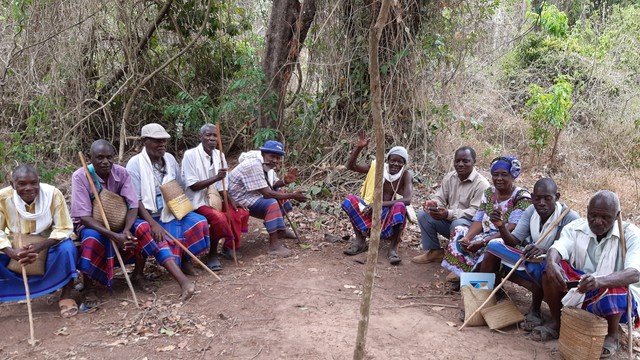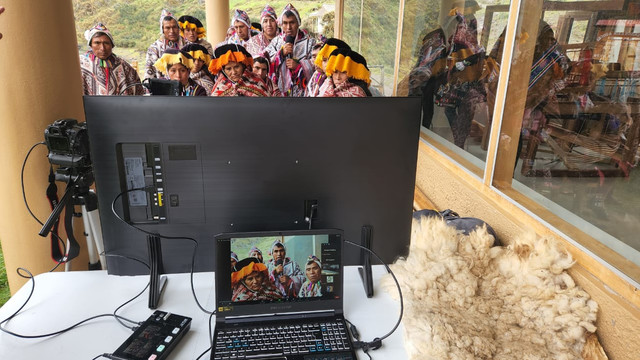Food waste: can grassroots initiatives stop us throwing good food in the bin?
Almost half the food the world produces is thrown away. Reducing food waste is an economic, ethical and environmental challenge which grassroots initiatives are starting to address.


Seeds carefully picked from a pile of rotting and old beans in Mali. Photo: Copyright, Khanh Tran-Thanh
The world produces 4 billion metric tonnes of food for human consumption each year. But according to figures published earlier this year 30% to 50% of it never reaches our stomachs. Poor practices when harvesting, storing and transporting the food, as well as market and consumer wastage, are to blame.
Major supermarkets in the UK often reject entire crops of edible fruit and vegetables at the farm because they do not meet consumer expectations for size and appearances. For example, four tonnes of mutant parsnips were not harvested because they failed to meet required commercial standards after they were hit by heavy rain last year.
 Compare this attitude to the care taken by the Coopérative Alimentaire de Sélingué – a women’s cooperative which prepared food for an IIED-led meeting I attended in Mali. One lady I observed was bent over a basket full of green beans. At first glance they looked rotten. The beans were shrivelled and some were mouldy. If this lady had been using the standards of any western supermarket, these beans would’ve been thrown out. But she patiently picked out all the beans that were still suitable for cooking, meticulously cutting out any unwanted bits. She cracked open the pods to get the seeds for replanting from those that really were unsuitable to eat.
Compare this attitude to the care taken by the Coopérative Alimentaire de Sélingué – a women’s cooperative which prepared food for an IIED-led meeting I attended in Mali. One lady I observed was bent over a basket full of green beans. At first glance they looked rotten. The beans were shrivelled and some were mouldy. If this lady had been using the standards of any western supermarket, these beans would’ve been thrown out. But she patiently picked out all the beans that were still suitable for cooking, meticulously cutting out any unwanted bits. She cracked open the pods to get the seeds for replanting from those that really were unsuitable to eat.
Consumers in rich countries waste almost as much food (222 million tonnes) as the entire net food production of sub-Saharan Africa (230 million tonnes) every year. Broken down at the household level, in Europe and North America, per capita household waste by consumers is between 95-115 kg a year. In comparison consumers in sub-Saharan Africa, south and south-eastern Asia, each throw away only 6-11 kg a year.
This is why the United Nations Environment Programme (UNEP) has been promoting traditional methods by cultures around the world of preserving food. The 5 June is World Environment Day, an annual event that celebrates global environmental action. The theme this year is Think Eat Save – an anti-food waste campaign. Achim Steiner, Executive Director at UNEP, says that reducing food waste is an economic, ethical and environmental challenge that links to the greatest challenges today – from hunger and nutrition, to climate change, deforestation and land degradation.
Learning how less-wasteful cultures place value on every morsel of food could help us contribute to these challenges.
How food is wasted
According to a recent report by the United Nations Food and Agriculture Organization, 40% of food losses in developing countries occur at the farmer-producer end of the supply chain. This is due to inefficient harvesting, inadequate local transportation and poor infrastructure.
In industrialized countries – because of better processing, transport and storage technology – a larger proportion of food reaches markets and consumers, where over 40% of losses happen.
Food loss at the consumer end is cultural. In developing countries, poverty and limited household income make it simply unacceptable to waste food.
In developed countries, the responsibility for planning family meals, and maintaining a stock of foodstuffs, fresh and preserved, has been appropriated by the industrialised food chain. A growing number of the world’s population is removed from the food supply system and has no understanding of it – becoming mere food consumers at the end of the supply chain. This creates a culture which places little value on food, making it ‘easier’ to throw it away and buy more from our overstocked supermarkets.
Initiatives reducing food waste
 I visited Qechua communities living in the Parque de la Papa, or Potato Park near Cusco, Peru in the Andean mountains. In a bid to revive the cooking of traditional local food varieties, a cooperative of women have set up Papamanka, a sustainable restaurant. The women there demonstrated a deep respect for the ingredients and the land on which their food was grown. “Food waste here is practically nonexistent,” the cooperative’s director, Celia Montalvo Acurio explained to me. “To cut a potato without eating it would be an insult to Pachamama, Mother Earth, and would bring us bad luck.”
I visited Qechua communities living in the Parque de la Papa, or Potato Park near Cusco, Peru in the Andean mountains. In a bid to revive the cooking of traditional local food varieties, a cooperative of women have set up Papamanka, a sustainable restaurant. The women there demonstrated a deep respect for the ingredients and the land on which their food was grown. “Food waste here is practically nonexistent,” the cooperative’s director, Celia Montalvo Acurio explained to me. “To cut a potato without eating it would be an insult to Pachamama, Mother Earth, and would bring us bad luck.”
Such belief is part of the collective biocultural heritage in the region, much of which is based on a reciprocal relationship between the people and their environment.
In the UK, a growing number of initiatives put surplus food into productive recycling. FareShare redistributes surplus food to a network of community organisations that support vulnerable people. It acts as a waste management company handling a business’s waste.
Last Saturday 1 June, Feeding the 5000 held an event in Bristol, UK serving a free lunch to 5000 members of the public – all made from fresh food that would otherwise have gone to waste.
Foodcycle is a charity combining volunteers and surplus food to create meals for people affected by food poverty. It regularly teams up with eco-chef Tom Hunt’s Forgotten Feast to run a pop-up restaurant using ingredients donated by from suppliers with surplus stock.
And what about the wonky vegetables? At the People’s Supermarket – a sustainable and socially conscious alternative to a regular supermarket – you can buy misshapen fruit and vegetables, that other supermarkets reject, for half the going market price.
In an emerging economy like China household incomes and overall food consumption continue to rise. On a recent trip to the country I was stunned by the piles of half-finished dishes left on restaurant tables. And, at the same time, problems like increased food waste, natural resource scarcity and overflowing landfills soar.

But even here, in a country famed for its lavish banquets, a grassroots initiative called Operation Empty Plate has had a sweeping effect. The call for action started with a photo of an empty plate on weibo, the Chinese version of twitter. It became a nationwide campaign when the Communist Party's new leader, Xi Jinping, publicly endorsed it. An increasing number of citizens and organizations have joined in. More and more people are aware of the issue and are now willing to act.
The world will need to feed 9 billion people by 2050. Improving the sustainability of food production is central to meeting the future food demands of all those new people. But there is little benefit in increasing production when almost half of the food produced is simply thrown away.
Now is the time to redress the balance, recognise the value of food, and contribute to global efforts to reduce waste.



